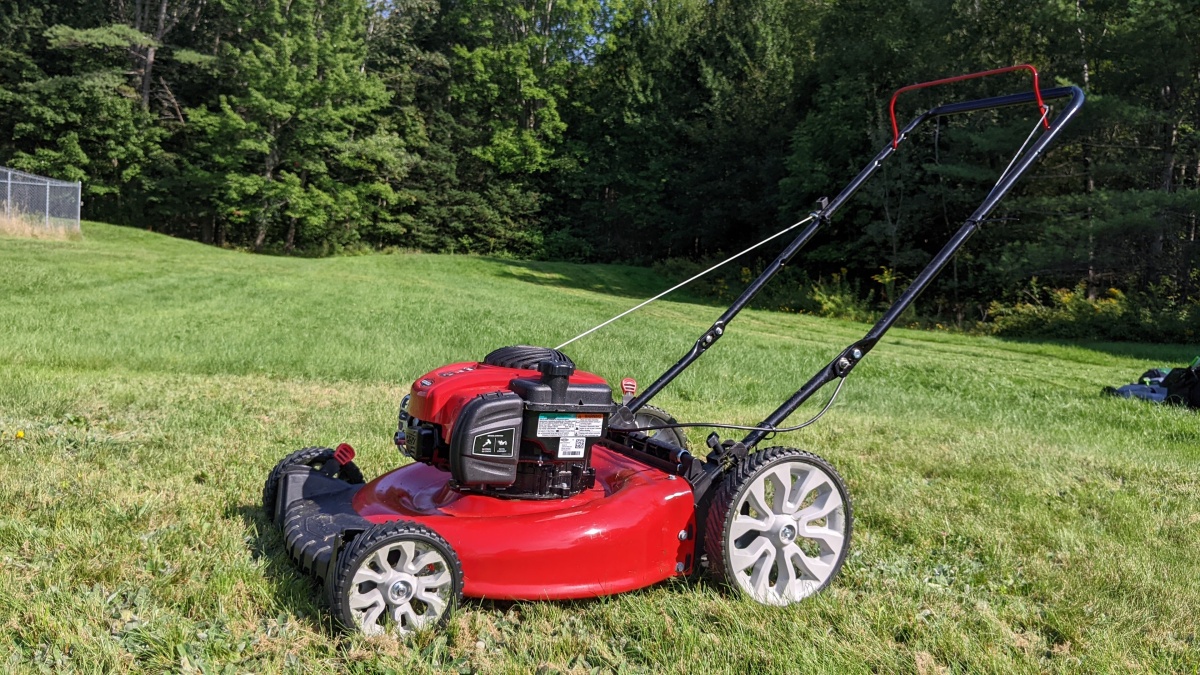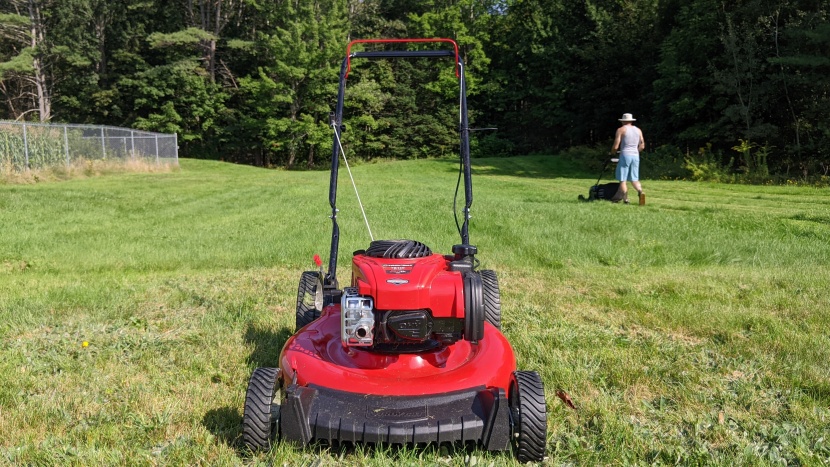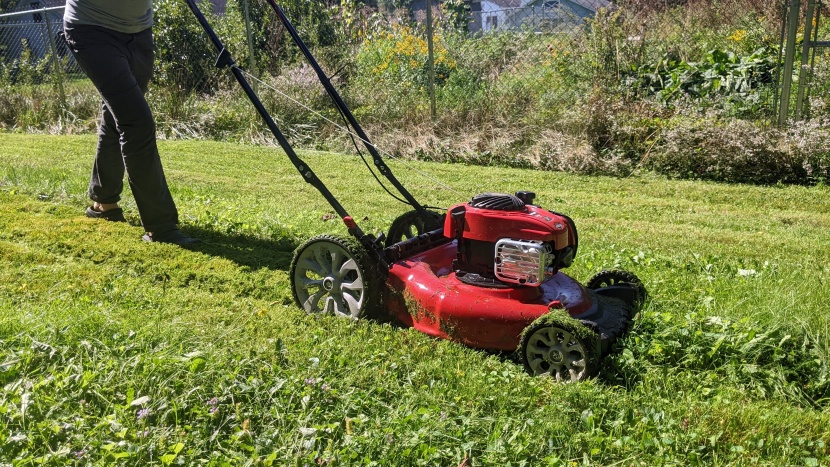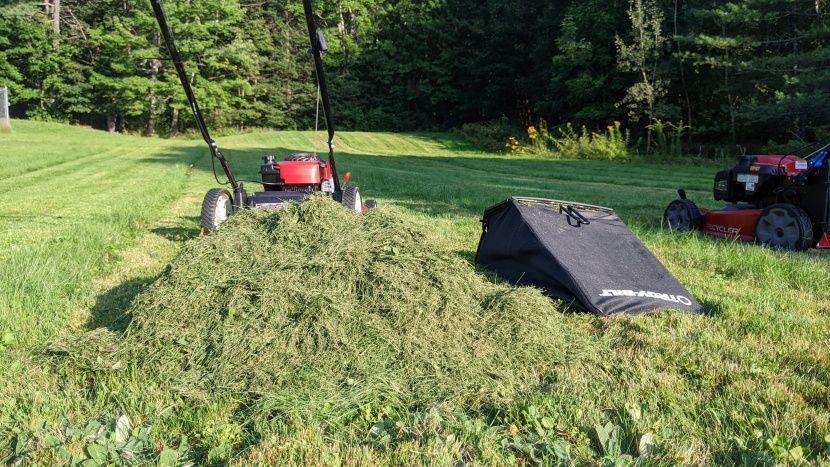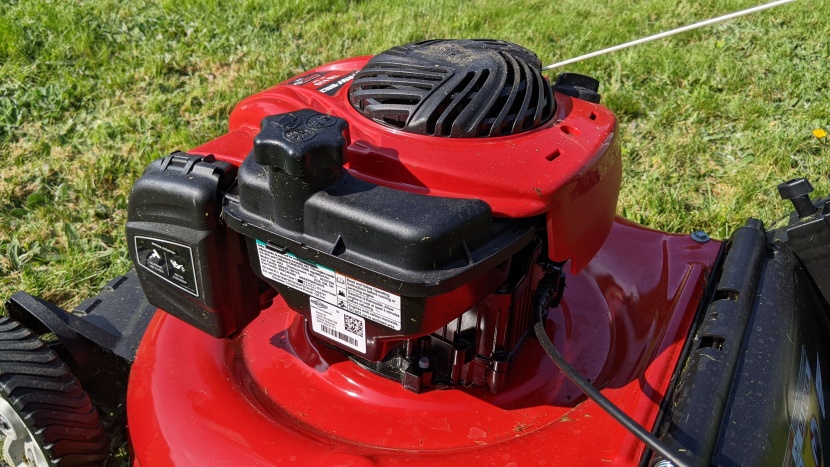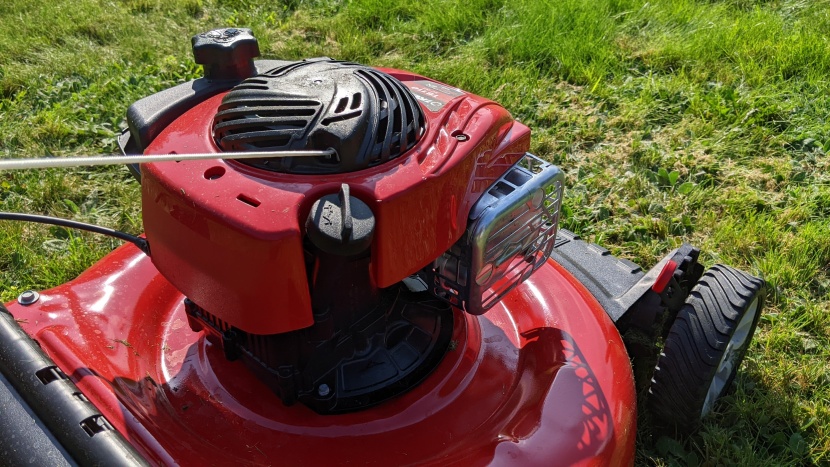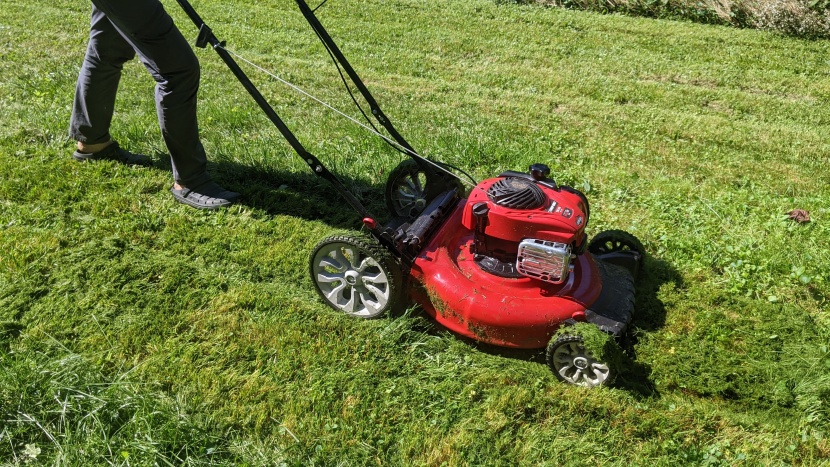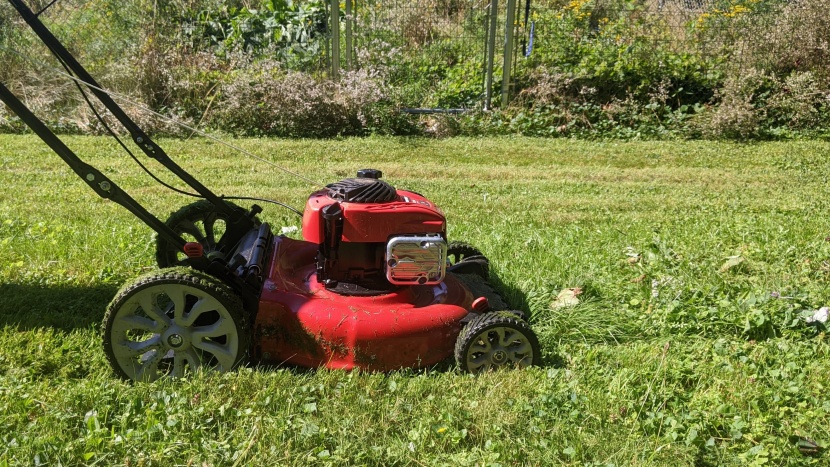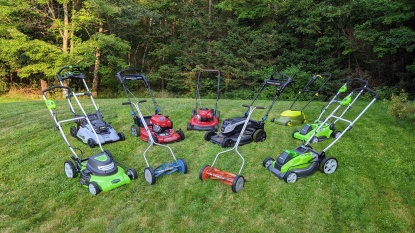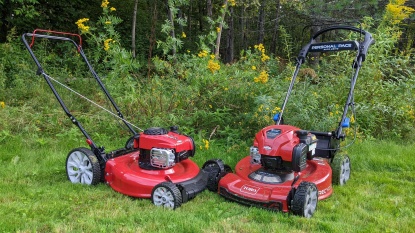Our Verdict
Compare to Similar Products
 This Product Troy-Bilt TB110 | |||||
|---|---|---|---|---|---|
| Awards | An Affordable Fuel Version | Best Overall Lawnmower | Best Battery Model For Your Money | A Trusty & Reliable Classic | |
| Price | $369 List | $579 List | $300 List $299.99 at Amazon | $150 List $82.99 at Amazon | $150 List $83.99 at Amazon |
Overall Score  |
|||||
| Star Rating | |||||
| Bottom Line | Sturdily built with a trusted engine, this high-performing motor should last | The reliability of a steel deck and Briggs and Stratton motor with the convenience of self-propulsion | An affordable, electric mower that's perfect for small yards | A solid manual option for those with small yards and simple tastes | This easy-to-use manual reel mower was dull and required some adjustment |
| Rating Categories | Troy-Bilt TB110 | Toro SmartStow Recy... | Greenworks 25322 | American Lawn Mower... | Great States 204-14 |
| Mowing (35%) | |||||
| Power Performance (25%) | |||||
| Handling (20%) | |||||
| Ease of Use (15%) | |||||
| Noise (5%) | |||||
| Specifications | Troy-Bilt TB110 | Toro SmartStow Recy... | Greenworks 25322 | American Lawn Mower... | Great States 204-14 |
| Power Source | Gas | Gas | 40V, 4Ah Lithium Battery | Reel | Reel |
| Cutting Deck Width | 21" | 22" | 13 3/4" | 14" | 14" |
| Self-Propelled | No | Yes | No | No | No |
| Measured Cutting Gap | 1/4" | 1/2" | 1" | N/A | N/A |
| Measured Recharge/Refuel Time | 2 min | 2 min | 65 min | n/a | n/a |
| Measured Decibel Reading | 79 dBa | 81 dBa | 72 dBa | 66 dBa | 66 dBa |
| Watt Hours | N/A | N/A | 160 | N/A | N/A |
Our Analysis and Test Results
A classic, gas-powered mower, the Troy-Bilt TB110 uses a tried and true design. With plenty of power, a simple design, no bells and whistles, and minimal moving parts, we expect it to do the job well for years to come.
Mowing
The Troy-Bilt TB110 delivers the most consistently clean and even cut in our tests. While other options outperform it in specific circumstances by using task-specific blades and settings, if you don't want to think too much about your mower, this is an excellent option. Just push it around your yard and walk away with a lovely lawn.
This mower is the best option in the lineup for damp grass. When some of the other top-performing options shuttered to a stop with a clump of wet grass clogging the blade, the TB110 powered through. On the downside is that the Troy-Built is much more work to push through tall or heavy grass than our favorite self-propelled options. With this traditional mower, you're just muscling through.
In one of our tests, we fought through a thick stand of foot-tall grass. Instead of gliding through the section like the top performer in the test, it seized to a stop. We probably could have worked it through with more finesse and shouldn't have been cutting grass that tall, to begin with, but that's how we find limits. (Check the end of the review to find out which mower plowed through that test.)
Evenness and Terrain Management
Again, though, when cutting grasses in a reasonable height range (between four and seven inches in most of our tests), the TB110 is a standout. The relatively heavy steel deck hugs the ground where lighter mowers bounce over divots, missing patches of grass. We also noticed less patchiness and fewer tufts of grass left behind by this mower than any of the rest.
Mulching
From our first mowing test onward, the TB110 has been a standout when it comes to mulching grass. We rarely found any long strands left behind when raking through its wake. This is especially important because many lawn experts recommend mulching grass cuttings to maintain your lawn's health.
The only time we noticed clumps of grass forming was when the grass was damp with dew or a recent rainstorm. Though the TB110 dealt with these conditions better than any other option in the test, it did leave a ring of grass on the ground whenever we stopped for a moment, and some of the cut grass was left in small piles on the lawn.
Bagging
True to form, this mower is a capable bagger as well, packing cuttings densely so you don't have to empty it as often. It did get a little congested for a moment in a dense patch of grass, but we simply slowed our walk to let it catch up. We found almost no grass left behind in our bagging tests; it was just a strand here or there.
Most landscaping specialists recommend mulching because bagging grass removes nutrients from your lawn, while mulching helps retain moisture and cool the soil. But if you need to use this machine to bag your grass on occasion, you certainly can.
The TB110 we tested didn't come with a side shooting attachment, so we didn't test its performance with one.
Cutting Deck Width and Height
The 21-inch steel deck makes the most of each pass you make. It has six settings to adjust its height from 1 inch to 3.5 inches, giving you a 2.5-inch range. We tested this mower in its middle setting, #4, which measures 2.25 inches.
Power Performance
Small, gas-powered engines have been mowing lawns for a long time. They're a known entity, and many owners have acquired a knack for keeping them running or know someone who can. That reliability gives gas-powered lawn mowers an edge over the newer, battery-powered options. They also don't force you to wait for a battery to recharge if you run out of juice—just add more gas. That makes gas mowers like the TB110 a tempting option for large lawns.
Given the global push to move away from fossil fuels, now could be the right time to consider moving toward electric options when replacing important household appliances and toolsets. Should a gas-powered mower not be what you are looking for, we have an entire review on battery lawn mowers.
Handling
The classic TB110 is a standard mower and lacks the self-propulsive boost of our favorite options. With large and narrow wheels in the rear and small ones up front, it pivots and turns exceptionally well, making it incredibly maneuverable around turns and obstacles. The steel deck resists flexing, so it maintains a clean cut around turns.
Still, this mower suffers in comparison to the cushy, self-propelled options in the test. You feel the full weight of this mower when pushing it around your yard and have to perform the longstanding lean to leverage it up a hill. These days, when many lawn mowers can practically walk themselves, that's less and less appealing.
The TB110's handle and bail bar are very narrow, offering no cushing at all and forcing your hands and forearms to work harder to maintain your hold. The large foam handles of many competitors allow your hands to relax, keeping you feeling fresh and strong for longer.
Ease of Use
The simplicity of the TB110 makes it relatively easy to use. It has a traditional pull-start. Simply hold the bail bar down and pull back on the handle with steady force. It's not difficult, but it is more labor-intensive than the push starts on many of the electric options. When you release the bail bar, the blade stops promptly, in about a second.
Changing Mowing Heights
To change the height of the mowing deck, you have to adjust two levers, one on the back right wheel and one on the front. This is easier than adjusting each wheel individually, like some options we tested, but it is more troublesome than using one handle to adjust the entire mower, like many of the lightweight options.
It's also challenging to find out how high each setting adjustment is. We gave up and just measured it. The blade is 0.25 inches from the bottom of the deck, and the bottom of the deck is 2.25 inches from the ground in the #4 setting, which is the one we used throughout the test.
Folding
The mower's handle is supposed to fold in half at a pivot point with screws you can loosen by hand. We weren't able to test this feature since the mower arrived without the appropriate parts. We bolted it together with spare parts and reached out to the company to see about obtaining replacements. It was not a straightforward process, and we ended up throwing the towel in and testing it as is.
Maintenance
While small engine maintenance can be annoying, it's not difficult. If you're used to it, maintaining this mower will be straightforward. You'll need to make sure the oil levels are consistent, keep it filled with gas, and be prepared to winterize it if you live in a cold climate.
If you don't have a few tricks up your sleeve when it falters, call around for a good small engine repair person in your neighborhood. Based on our experiences with similar machines, we expect this mower to last a decade or more, especially since all its parts are easy to replace.
Set Up
Since setup is a one-time deal, we don't give it too much weight in the scores. The TB110 started out promisingly, arriving with a “low waist” plastic pouch holding just enough oil for the engine. When we poured it in, it measured just over the full line but settled in nicely over time.
Less fortunately, the promisingly simple-looking quickstart guide was not actually very helpful. Some of the confusion arose from missing parts. The mower arrived missing a red turn knob and two carriage bolts to connect the upper portion of the handle to the lower. We cut two spare bolts down to size to make it work.
Noise
Among the loudest mowers in the test, we measure 79 decibels at head height when this machine is running. It spikes louder when you start it up, often leaving you in a cloud of smoke. According to the World Health Organization, you can listen to 40 hours of noise at or below 80 decibels each week before you have to worry about hearing loss. So hearing loss probably isn't a concern. The electric options are quieter though.
Should You Buy the Troy-Bilt TB110?
The TB110 offers a beautiful cut and solid mulching skills. It will also bag your grass beautifully if you'd prefer. The Briggs & Stratton engine promises to mow as much grass as you'd like, as long as you have the gas for it. And we expect such a respected motor to fire up reliably for a good long while, making the reasonable price point even more appealing over time. You will be at the mercy of the market when it comes to gas prices, but lawn mowers are pretty fuel-efficient. On the downside, this mower isn't much fun to use. It lacks the labor-saving self-propulsion and the cushioned, forearm-friendly handles of the top-ranking options. It's also not going to help you make the shift from gas to electric power, which many think is necessary to avert a climate disaster.
What Other Lawn Mower Should You Consider?
If you want to familiarize yourself with a gas-powered mower with the modern convenience of an auto-drive version that will practically walk itself, check out the Toro SmartStow Recycler 20340. It's pricey and produces a less meticulously perfect cut, but it's extremely pleasant to use. If you've got a bit more cash to spend, want to buy electric, have a smaller yard, or don't mind cutting it in stages, the Toro 60V Max 21" Super Recycler has the same auto drive as the gas Toro but will let you run your mower on solar or wind born power. The limited battery life may have you mowing in stages, though.


